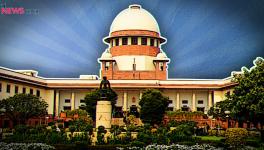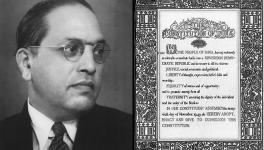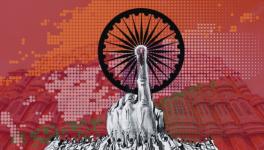One more "lifeline" for the CA in Nepal
The repeated extension of the Constituent Assembly and political deadlocks in Nepal is a consequence not only of the inability of the Nepali polity to forge a consensus but also the unnecessary meddling by the Indian government in Nepal.
Yet another nail biting round of contested parleys, yet another dawning of sense at the final minute, and yet another extension of the Constituent Assembly - this time by three months. The latest developments in the unending story of political intrigue between the four major political forces in Nepal - the Maoists, the UML, the Nepali Congress and the more amorphous and variegated Madhesi parties provide the Nepal watcher a sense of deja vu. Similar scenes were played out last year, when then prime minister Madhav Nepal agreed to resign as per a four point agreement paving the way for election of a new prime minister, a process that took a farcical route before Jhalanath Khanal of the UML was finally elected. This time around, Khanal has been made to do what Madhav Nepal underwent and while differences remain as to when Khanal will put in his papers, it seems it is more a question of when rather than if he would do that.
Issues that have bedevilled the prospects of a national consensus government involving all political parties as the Constitution writing process is shepherded - remain mostly unresolved, even if significant steps have been taken on matters such as the integration/rehabilitation of Maoist combatants into the Nepali armed forces. But consensus is not an one way street as the Maoists claim with some justification - they have traversed some distance on the issue of their Peoples' Liberation Army's integration/rehabilitation. Or it seems elusive as the other parties, particularly one section of the UML and the Nepali Congress unwilling to trust the Maoists on this account requiring them to disband the PLA preceding any movement on the Constitution writing process. That the Maoists themselves are divided ideologically has not helped.
In many ways, as time goes by, the repeated extension of the Constituent Assembly and the serial incompetence of the political class in thrashing out their differences and get their act together in getting to do what the people wanted them to do in the first place - get a Constitution for the republic of Nepal, has thrown up several question marks. But as had been argued before, there is more than just internal differences and class politics that is creating this untenable situation.The meddlesome role of the Indian establishment in this whole process, the sheer "negativism" - as The Hindu editorialises - evinced by Indian interlocutors trying to muddy up the situation by its influence writ large on various groups - the Madhesi ones in particular in Nepal requires commenting upon.
For some time, we have heard the refrain, obviously opinion shared by the Indian establishment that it is necessary for the "democratic" forces in Nepal to act as a bulwark against the Maoists whose intentions to create a Maoist controlled republic are "suspicious". Even by a simple perusal of the attitudes and actions of these "democratic" parties - the NC and the UML, it would be clear that they have hardly been "democratic" in their approaches. The UML was essentially the third biggest party after the CA elections, yet they have hankered hard to control the prime ministerial position; one of their prime ministers during the period was actually defeated soundly in the CA elections in two constituencies. The Nepali Congress' nominees for higher ministerial berths in the Madhav Nepal government also had that dubious distinction of being a loser. Both these parties have refused to consider that the Maoists have been democratically elected to being the leading political force in the country and the peace agreement between the Maoists and the rest of the polity was made on an equal footing, in other words according equal status for the PLA vis-a-vis the Nepali army. The Maoists are not blameless in the manner they went about certain steps as part of government, but the other parties have lacked in a democratic attitude for sure. It is therefore utterly false that a distinction can be made on the basis that the rest of the polity apart from the Maoists are "democratic" in nature.
Yet, this is precisely the lie that the Indian establishment has been using to drive a spanner in the political works in Nepal. The Indian embassy in Nepal has micromanaged the polity there to serve its goal of isolating the Maoists and this has badly influenced the primary constitutional process in itself. The strategy is akin to the George Kennan policy of containment adopted by the US against the Soviet Union, i.e., forcing the Maoists to be limited to a certain bargaining position and not beyond and therefore away from power at any cost. This has spawned distrust among the political actors and has also strengthened what many call is a "dogmatic" faction with the Nepali Maoists themselves who consider the Nepali Constitution making process through engagement with other actors futile and have argued for a larger insurrection. In many ways, the Indian establishment has precisely wanted this to happen - hamper the CA process and make the Maoists responsible for it, bringing them to further isolation.
It is interesting to notice this ploy by the Indian establishment which is a direct contrast to its attitudes to the Nepali political processes of reconciliation and republicanisation between 2005-07. The Indian establishment then had supported the pact between the Maoists and the other political parties, seeing it as a stabilising process after the monarchy lost any legitimacy it had with the Nepali populace. But then it was not an enthusiastic gesture by the Indian establishment then. It is clear that the role of the Indian left which had supported the UPA government from outside was crucial in the clinching of the peace agreement through Indian support and a shift from the meddlesome role of the past. Once the Indian Left withdrew support to the UPA and consequently has been marginalised from the echelons of policy making and power, the meddlesome, Machiavellian and narrow sighted policy making in Nepal by the Indian establishment has come back with a vengeance. Painting the Maoists as a strategic enemy capable of weaning away Nepal from Indian hegemony and bringing it closer to China geopolitically, the Indian establishment has steadfastly tried to contain the Maoists in Nepal, politically, strategically and limiting its ability to influence policy making.
From a broader viewpoint, this stance of the Indian government seems utterly self-defeating and poorly conceived. The Maoist presence in a constitutional regime should ideally foster a social revolution in a long stratified Nepali society and state, helping the release of productive and democratic impulses in one of the poorest regions in the world. That should have a normatively positive effect on neighbouring areas in India - in Bihar and Uttar Pradesh as well. But the Indian establishment sees the "revolutionary" visage of the Nepali Maoists as a threat, painting them with the same colours as the Indian Maoists with whom the Nepali Maoists have fundamental differences conceptually about the nature of "revolution", as also the steps to be taken in the medium term before achieving socialism. Indeed, by containing the Maoists and refusing them a means to articulate a progressive viewpoint in coalition and consensus with the other political actors, the Indian establishment have given sustenance to the dogmatic faction's claims of the need for an immediate hearkening back to the insurrectionary phase akin to the Indian Maoists' current praxis; a disastrous move that could take Nepal several steps back and into even more unnecessary political turmoil.
There is indeed a chance that something might work out to prevent any complete destabilisation of the CA process. At one level, some sort of accord in the spirit of 2005 has to be reached between the two largest parties - the Maoists and the Nepali Congress. There remains a certain degree of republicanism and progressivism among some sections with the Nepali Congress, with whom a degree of understanding on pressing matters can indeed be reached if both parties show sagacity. Among the UML itself, formally a recognition exists (again among a certain current within the party) for the need of a national consensus government in the immediate. Differences over the sequencing of the "integration/ rehabilitation" process can be overcome through dialogue that involves trust. While, other matters in the writing of the constitution - the nature of federalism, the form of government - these being the issues where differences are most well laid about among the polity - can be sorted out through a constitutional referendum involving a direct vote from the public themselves if indeed there is no resolution in the CA itself. But for a positive intent to hold sway, Indian influence has to shift from negativism and "containment" of the Maoists. There is no Left heft to articulate shifts in executive policy making now, but perhaps enough pressure can be generated through just the public knowledge of the negativist role of the Indian establishment.
Get the latest reports & analysis with people's perspective on Protests, movements & deep analytical videos, discussions of the current affairs in your Telegram app. Subscribe to NewsClick's Telegram channel & get Real-Time updates on stories, as they get published on our website.
























